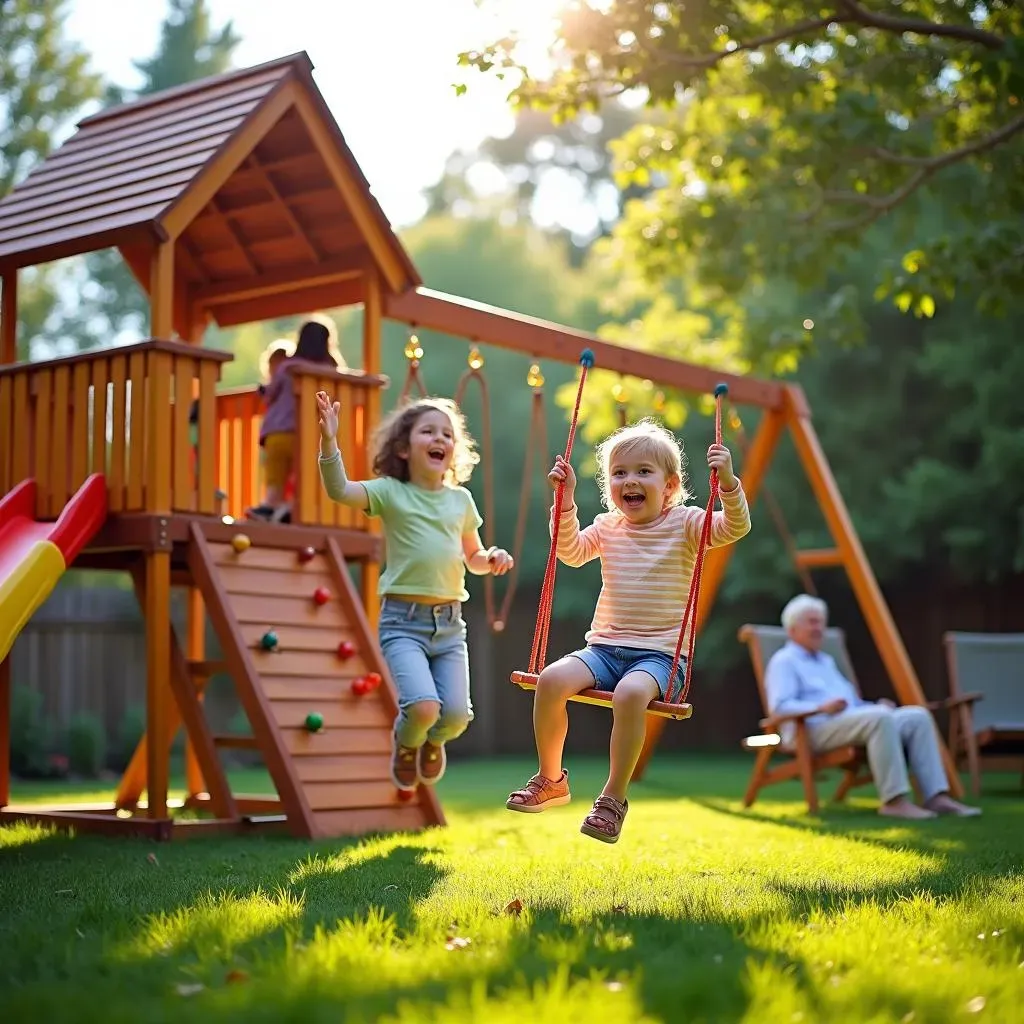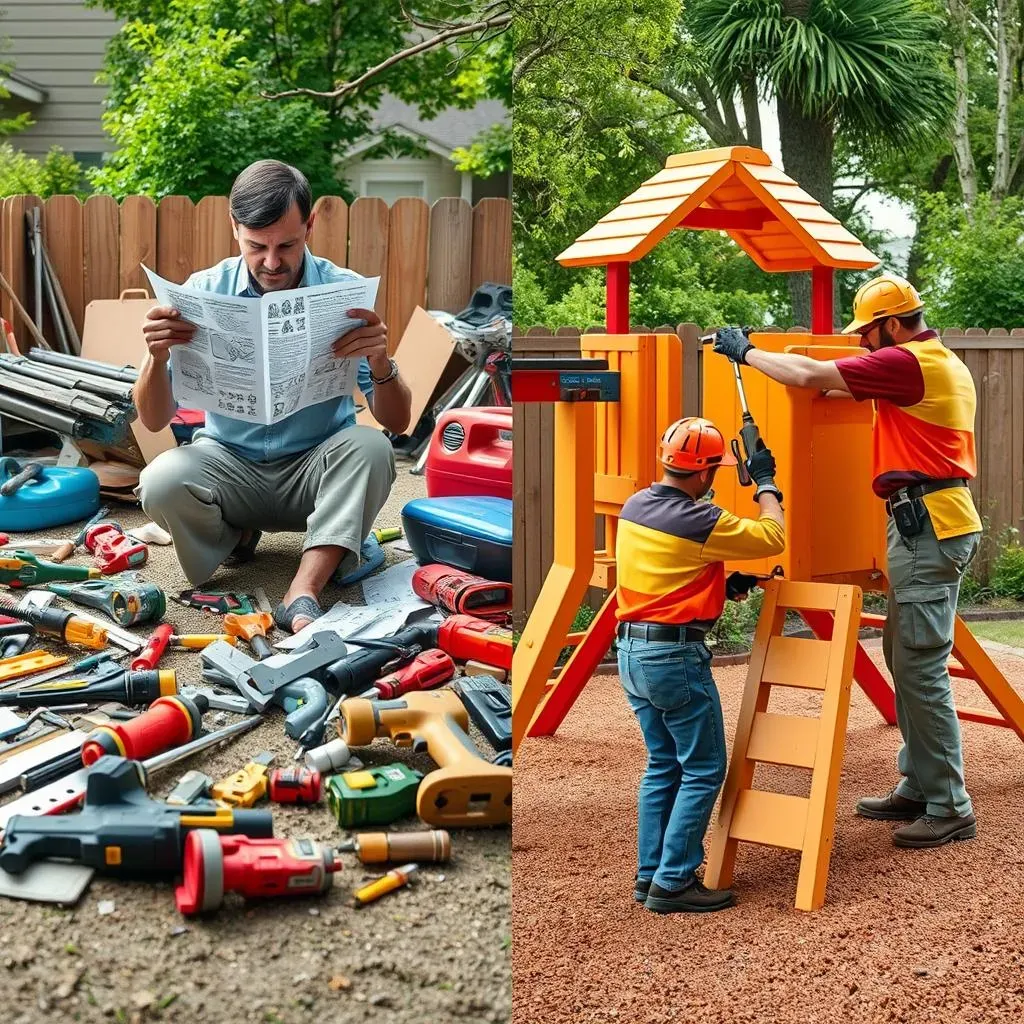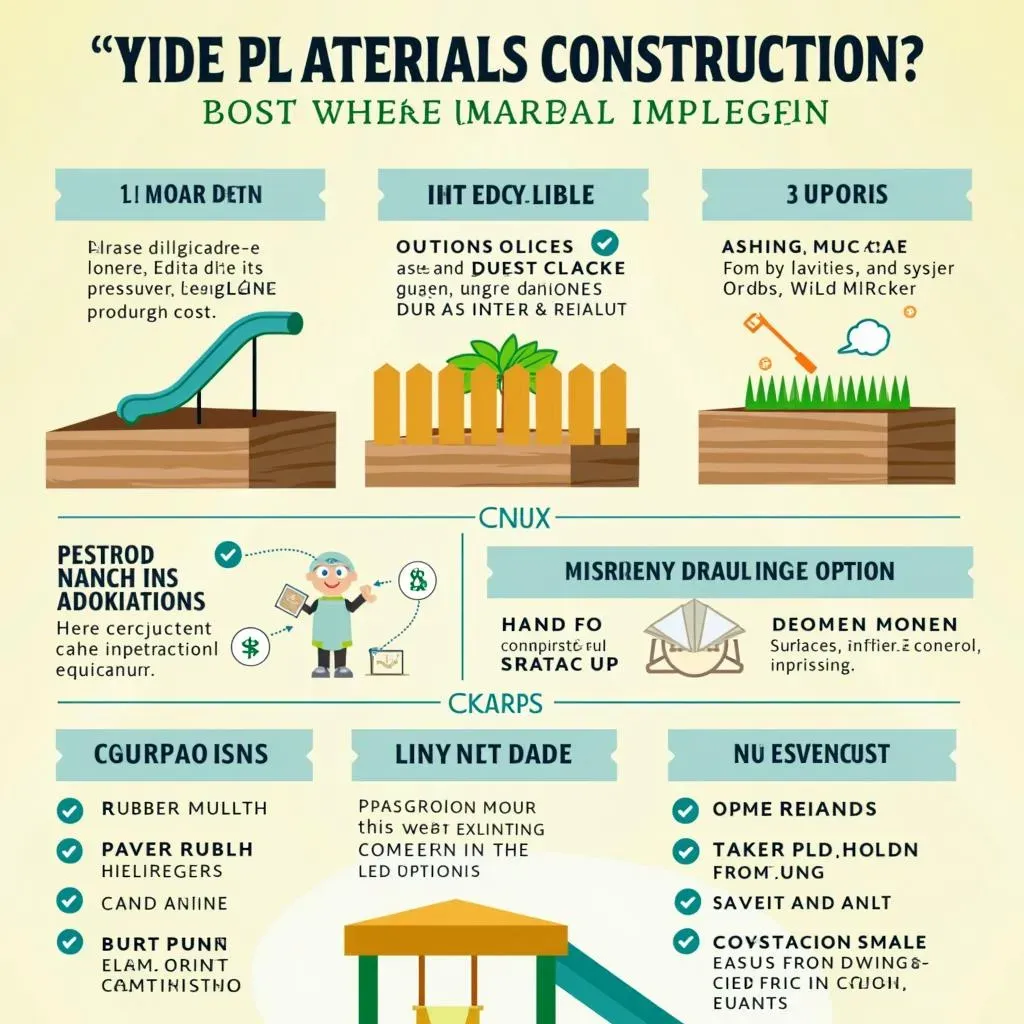Table of Contents
Dreaming of a backyard playground where your kids can burn off energy and create lasting memories? You're probably wondering, "How much does a backyard playground cost?" The answer, like most things in life, isn't a simple one. Building a backyard playground can range from a few hundred dollars for a basic swing set to several thousand for a custom-designed play area with all the bells and whistles. This article breaks down all the factors that influence the final price. We'll explore the costs of different types of swing sets, the pros and cons of DIY versus professional installation, the expenses associated with lumber and surfacing materials, and how popular brands stack up in terms of price and features. We'll also delve into those often-overlooked costs like permits and yard leveling. By the end, you'll have a clear understanding of what to expect and how to create a fun and safe play space without breaking the bank. So, let's jump in and explore the world of backyard playground costs!
Swing Set and Playground Costs: What to Expect

Swing Set and Playground Costs: What to Expect
Basic Swing Set Prices
So, you're diving into the world of backyard playgrounds? Awesome! First things first, let's talk about swing sets. A basic, no-frills swing set with a couple of swings and maybe a small slide can start as low as $80. These are usually made of metal or basic plastic and are perfect if you're on a tight budget or have limited space. But remember, you often get what you pay for. These might not last as long or be as sturdy as higher-end options.
On the other end of the spectrum, you've got the deluxe swing sets. We're talking wooden structures with multiple swings, slides, climbing walls, and even little playhouses attached! These can easily run you $1,500 or more. The materials are generally higher quality, and they're built to withstand years of use (and abuse) from energetic kids. Think of it as an investment in their childhood fun!
Installation Costs: DIY or Hire a Pro?
Now, let's factor in installation. If you're handy and have some free time, you can definitely tackle the installation yourself. Just be prepared to spend a weekend (or maybe two!) wrestling with instructions and hardware. But if you'd rather skip the hassle, you can hire a professional installer. This will add to the overall cost, typically ranging from $150 to $900, depending on the complexity of the swing set and your location. It's a worthwhile expense if you value your time and want to ensure the playset is assembled safely and correctly.
Consider this: professional installation not only saves you time but also reduces the risk of injuries from improper assembly. Plus, many installers offer warranties on their work, giving you peace of mind knowing that your investment is protected. It's all about weighing the pros and cons to see what fits your budget and skill level.
Factor | DIY | Professional Installation |
|---|---|---|
Cost | Lower initial cost | Higher initial cost |
Time | Significant time investment | Minimal time investment |
Skill Level | Requires DIY skills | Requires no DIY skills |
Safety | Responsibility on homeowner | Ensured by professionals |
DIY vs. Professional Installation: Saving Money on Your Backyard Playground

DIY vs. Professional Installation: Saving Money on Your Backyard Playground
The Allure of DIY: Pocket the Savings
so you're thinking about building this playground yourself? I get it! The biggest draw is definitely saving money. By skipping professional installation, you can potentially save hundreds, which can then be channeled into upgrading the playset itself or adding cool features like a telescope or a sandbox. Plus, there's a certain satisfaction that comes with building something yourself, knowing you put in the sweat equity to create a fun space for your kids.
But before you grab your toolbox, let's be real. DIY isn't for everyone. It requires a decent amount of time, patience, and some basic construction skills. You'll need to be comfortable reading instructions, using power tools, and lifting heavy objects. And if you're not careful, you could end up spending more time (and money) fixing mistakes than you would have if you'd just hired a pro in the first place.
Tools of the Trade: Are You Equipped?
Speaking of tools, let's talk about what you'll need. At a minimum, you'll need a drill, a socket set, a level, a measuring tape, a hammer, and a saw. Depending on the complexity of the playset, you might also need a power screwdriver, a post-hole digger, and a wheelbarrow. If you don't already own these tools, you'll need to factor in the cost of renting or buying them. And trust me, using the right tools makes the job a whole lot easier (and safer!).
Also, consider safety gear! Eye protection, gloves, and sturdy work boots are essential. You don't want to end up with a splinter in your eye or a smashed finger. Remember, safety first! It's always a good idea to have a friend or family member help you with the installation, especially when lifting heavy components. Two sets of hands are always better than one, and it's more fun to build together!
When to Call in the Pros: Weighing the Benefits
Alright, let's be honest, sometimes hiring a professional is the smarter choice. If you're short on time, lack the necessary skills or tools, or simply don't want the hassle, a professional installer can be a lifesaver. They'll have the experience and expertise to assemble the playset quickly and safely, ensuring that it meets all safety standards. Plus, they'll handle all the heavy lifting and cleanup, leaving you with nothing to do but enjoy the finished product.
The cost of professional installation can vary depending on the size and complexity of the playset, as well as your location. It's always a good idea to get quotes from several different installers before making a decision. Be sure to ask about their experience, insurance, and warranty policies. A reputable installer will be happy to answer your questions and provide references.
- Time Savings: Free up your weekends.
- Expertise: Ensures proper and safe assembly.
- Warranty: Protection against installation errors.
- Convenience: No heavy lifting or tool worries.
Material Costs: Lumber, Surfaces, and Playground Equipment Prices

Material Costs: Lumber, Surfaces, and Playground Equipment Prices
Lumber: Picking the Right Wood for the Job
Alright, so you've decided to go the DIY route? Awesome! Now, let's talk lumber – the backbone of any wooden playset. The type of wood you choose will significantly impact the cost and the longevity of your playground. Pressure-treated lumber is a popular choice because it's resistant to rot and insect damage, but it can be pricier than untreated options. Cedar is another great option; naturally resistant to decay and looks fantastic. However, it also comes with a higher price tag. For a more budget-friendly approach, you might consider pine, but keep in mind that it will require regular sealing and staining to protect it from the elements.
When estimating lumber costs, remember to factor in not just the price per board foot but also the amount you'll need for the entire structure. Draw up detailed plans beforehand to avoid overbuying (or worse, underbuying!). Also, don't forget to account for waste – you'll inevitably have some scraps and cutoffs. A good rule of thumb is to add about 10-15% to your lumber estimate to cover these inevitable losses. Trust me, it's better to have a little extra than to run out mid-project!
Surfacing: Soft Landings are Non-Negotiable
let's talk about something super important: surfacing. This isn't just about aesthetics; it's about safety. You want to make sure your kids have a soft landing in case of falls. There are several options to choose from, each with its own pros and cons. Rubber mulch is a popular choice because it's durable, low-maintenance, and provides excellent shock absorption. However, it can be one of the more expensive options. Wood chips are a more budget-friendly alternative, but they require more frequent replenishment and aren't quite as shock-absorbent as rubber mulch.
Poured rubber is another option that provides a seamless, accessible surface, but it's definitely a premium choice in terms of cost. Sand is a classic playground surface, but it requires regular raking and can be a magnet for cats (yuck!). And then there's grass – while it's the most natural and affordable option, it provides very little impact protection and can quickly turn into a muddy mess. When choosing your surfacing material, consider your budget, your climate, and how much maintenance you're willing to do. Remember, safety should always be your top priority!
Surfacing Material | Cost (per sq ft) | Pros | Cons |
|---|---|---|---|
Rubber Mulch | $2 - $4 | Durable, low-maintenance, excellent shock absorption | More expensive |
Wood Chips | $1 - $3 | Budget-friendly | Requires frequent replenishment, less shock absorption |
Poured Rubber | $8 - $15 | Seamless, accessible, excellent shock absorption | Most expensive |
Sand | $0.50 - $2 | Classic, affordable | Requires raking, attracts animals, less shock absorption |
Playset Brands and Total Backyard Playground Cost Considerations

Playset Brands and Total Backyard Playground Cost Considerations
Navigating the Brand Landscape: Gorilla, KidKraft, and More
Alright, let's dive into the world of playset brands! You've probably heard of names like Gorilla, KidKraft, and Rainbow. These brands offer a range of pre-fabricated playsets that can save you time and effort compared to building from scratch. Gorilla playsets are known for their durability and innovative designs, often incorporating features like rock-climbing walls and multiple slides. KidKraft offers more budget-friendly options that are perfect for smaller yards and younger children. And Rainbow playsets? Well, they're the Rolls Royce of playgrounds, known for their premium quality and customization options (but be prepared to pay a premium price!).
When choosing a brand, consider your budget, the size of your yard, and the age and interests of your children. Do they love climbing and swinging? Or are they more into imaginative play and building forts? Each brand has its own strengths and weaknesses, so do your research and read reviews before making a decision. Also, check to see if the brand offers installation services in your area. Some brands include installation in the price of the playset, while others charge extra. It's definitely worth considering this when comparing prices.
Hidden Costs: Leveling, Permits, and More
let's talk about those sneaky hidden costs that can creep up on you if you're not careful. First up: yard leveling. If your yard is uneven or sloped, you'll need to level it before installing the playset. This can involve bringing in heavy equipment and hauling in dirt, which can add a significant chunk to your budget. Depending on the extent of the leveling required, you could be looking at anywhere from $1,200 to $4,200. Ouch!
Then there are permits. Depending on your location, you may need to obtain a permit before installing a playset. Permit fees can range from $400 to $1,100, and the process can involve submitting detailed plans and waiting for approval. It's always a good idea to check with your local building department to see what the requirements are in your area. Ignoring permit requirements can result in fines or even having to remove the playset altogether. Not fun!
The Big Picture: Calculating Your Total Backyard Playground Cost
Alright, let's put it all together. To get a realistic estimate of your total backyard playground cost, you'll need to factor in the following: the cost of the playset itself (whether you're buying a pre-fabricated one or building it from scratch), the cost of installation (DIY or professional), the cost of surfacing materials, any necessary yard leveling or permits, and any additional features you want to add (like a sandbox or a picnic table). Don't forget to add a little extra for unexpected expenses – there's always something that comes up!
Creating a backyard playground is an investment in your children's health and happiness. By carefully planning and budgeting, you can create a fun and safe play space that they'll enjoy for years to come. And who knows, maybe you'll even get in on the action yourself! After all, who can resist the urge to swing on a swing set every now and then?
Cost Factor | Estimated Range |
|---|---|
Playset (Pre-fabricated) | $1,000 - $6,500 |
Playset (DIY) | $500 - $3,000 (depending on materials) |
Professional Installation | $150 - $900 |
Surfacing | $500 - $2,000 |
Yard Leveling | $1,200 - $4,200 |
Permits | $400 - $1,100 |
Bringing the Backyard Playground Dream to Life: Key Takeaways
So, how much does a backyard playground cost? As we've explored, it's a multifaceted question with answers that depend on your specific vision, DIY skills, and budget. Whether you opt for a simple swing set or a sprawling custom playground, understanding the costs involved—from equipment and materials to installation and surfacing—is crucial. Weigh the pros and cons of DIY versus professional installation to determine the best approach for your situation. Remember to factor in potential hidden expenses like permits and yard leveling. By carefully considering these elements, you can create a safe, fun, and engaging backyard play space that your kids will love for years to come, all while staying within your budget.